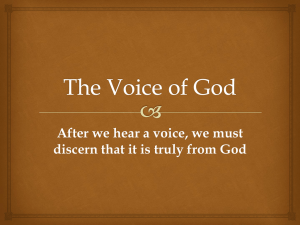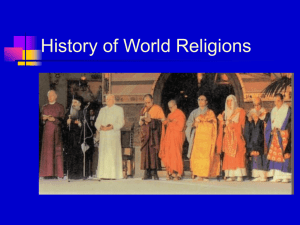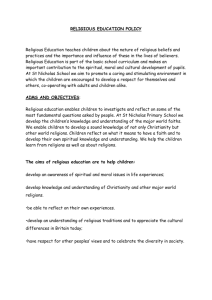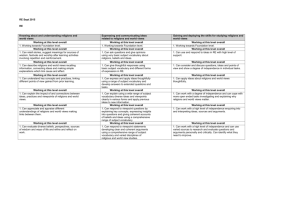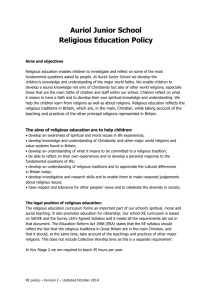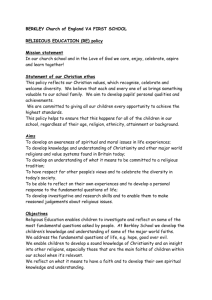Huston Smith`s Search for Wisdom in a Bewildered World
advertisement
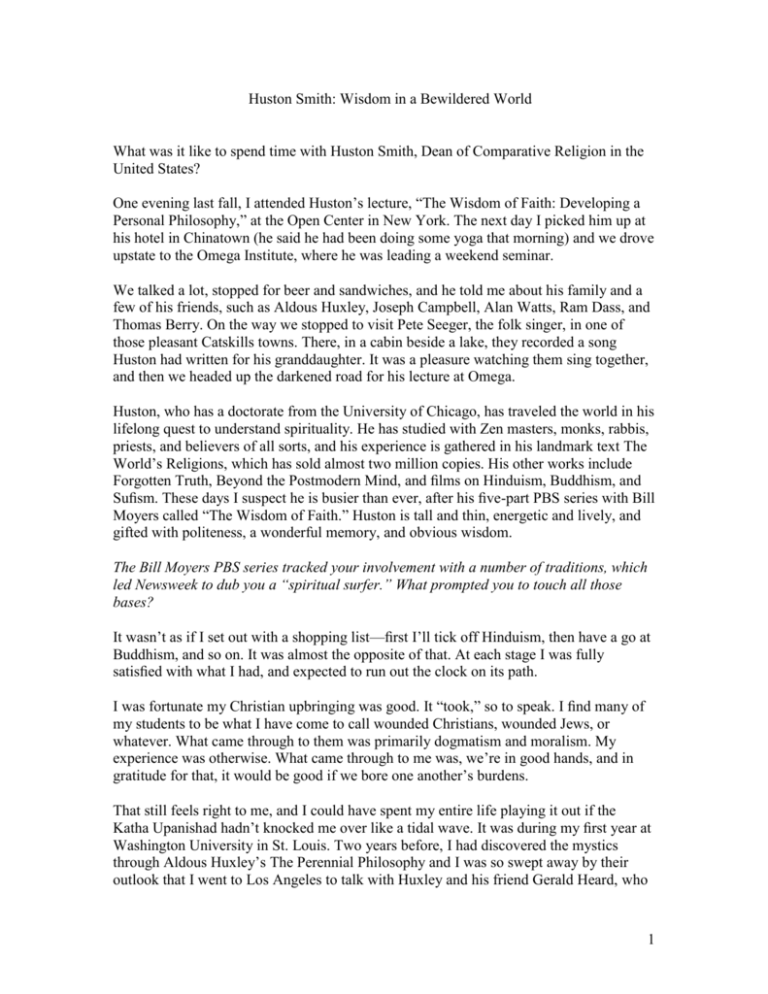
Huston Smith: Wisdom in a Bewildered World What was it like to spend time with Huston Smith, Dean of Comparative Religion in the United States? One evening last fall, I attended Huston’s lecture, “The Wisdom of Faith: Developing a Personal Philosophy,” at the Open Center in New York. The next day I picked him up at his hotel in Chinatown (he said he had been doing some yoga that morning) and we drove upstate to the Omega Institute, where he was leading a weekend seminar. We talked a lot, stopped for beer and sandwiches, and he told me about his family and a few of his friends, such as Aldous Huxley, Joseph Campbell, Alan Watts, Ram Dass, and Thomas Berry. On the way we stopped to visit Pete Seeger, the folk singer, in one of those pleasant Catskills towns. There, in a cabin beside a lake, they recorded a song Huston had written for his granddaughter. It was a pleasure watching them sing together, and then we headed up the darkened road for his lecture at Omega. Huston, who has a doctorate from the University of Chicago, has traveled the world in his lifelong quest to understand spirituality. He has studied with Zen masters, monks, rabbis, priests, and believers of all sorts, and his experience is gathered in his landmark text The World’s Religions, which has sold almost two million copies. His other works include Forgotten Truth, Beyond the Postmodern Mind, and films on Hinduism, Buddhism, and Sufism. These days I suspect he is busier than ever, after his five-part PBS series with Bill Moyers called “The Wisdom of Faith.” Huston is tall and thin, energetic and lively, and gifted with politeness, a wonderful memory, and obvious wisdom. The Bill Moyers PBS series tracked your involvement with a number of traditions, which led Newsweek to dub you a “spiritual surfer.” What prompted you to touch all those bases? It wasn’t as if I set out with a shopping list—first I’ll tick off Hinduism, then have a go at Buddhism, and so on. It was almost the opposite of that. At each stage I was fully satisfied with what I had, and expected to run out the clock on its path. I was fortunate my Christian upbringing was good. It “took,” so to speak. I find many of my students to be what I have come to call wounded Christians, wounded Jews, or whatever. What came through to them was primarily dogmatism and moralism. My experience was otherwise. What came through to me was, we’re in good hands, and in gratitude for that, it would be good if we bore one another’s burdens. That still feels right to me, and I could have spent my entire life playing it out if the Katha Upanishad hadn’t knocked me over like a tidal wave. It was during my first year at Washington University in St. Louis. Two years before, I had discovered the mystics through Aldous Huxley’s The Perennial Philosophy and I was so swept away by their outlook that I went to Los Angeles to talk with Huxley and his friend Gerald Heard, who 1 had converted him from his Brave New World cynicism to mysticism. As I was taking my leave, one of them said, “You’re moving to Washington University in St. Louis? There’s a very good swami there.” Swami? I’m not sure I knew then what the word meant. But I was hanging on to every word those men said, so the week that I arrived in St. Louis I looked up Swami Sat-prakashananda in the phone book. Learning that he was giving Tuesday evening talks on the Upanishads, I dropped in, and on leaving bought a copy of the Katha Upanishad, which I started reading on the streetcar ride home. That did it. Vendanta invaded me completely and took over my life for a decade because I found in it a metaphysical depth that was absent from the pietistic Christianity I had been raised on. Later I was to learn that Christianity had that depth too, but I didn’t know that then. So for ten years I studied with the swami. He was in the Ramakrishna Vivekananda Order of Vedanta, the metaphysical strand of Hinduism, and was remarkable. I had known great scholars before, and also deeply religious men, but never the two combined in a single individual. He was deeply learned—the other swamis in his order all had him check their translations because he was the best Sanskritist in the lot. And in addition he was the holiest man I had then encountered. Naturally, I apprenticed. For ten years, in weekly tutorials, he grounded me in the Vedanta, and he set me to meditating. He was also a godsend to my teaching. Realizing that Asia has been more open to mysticism than has the West, I had decided to add world religions to the philosophy courses I taught. My dean welcomed the move because it was right after World War II and the word had come down that universities should globalize their curricula in the hope that understanding other cultures might increase the prospects of peace. Though I had grown up in China I hadn’t studied Asia, and the swami was an ideal launching pad for what was to become my first interest, world religions. Having found Vedanta I was completely satisfied and would have stayed with it if Buddhism hadn’t crashed over me like a second tidal wave. Two years before I moved from St. Louis to MIT, D. T. Suzuki, Gary Snyder, and Jack Kerouac’s The Dharma Bums had brought Zen to media boil, so when I noticed that the list of Fulbright exchange scholars for the following year included a Japanese philosopher who was also a Zen priest, I got my dean to bid for him and we were successful. For a semester Ogata-sensei and I taught a course on Buddhism together, and I was again hooked, this time by the satori enlightenment experience that Zen dangled before me like a carrot. Ogata set things up for me to go to Japan for the summer I have already mentioned. Two decades later Sufism took over. It was while my wife and I were directing an academic year around the world and we were in pre-Khomeini Iran for seven weeks. The other religions didn’t preempt my life successively the way Christianity, Hinduism, Buddhism, and Islam did, but Judaism has become important for me through one of our daughters who married a conservative Jew and converted; we join their seders and 2 Shabbat observances whenever we can. The bar mitzvah of our grandson Isaiah was a profound experience for me, and the way their congregation closed in to support the family when my daughter died—sitting shiva and the rest—was even more important. My contact with the primal, tribal traditions began during our decade in Syracuse, where I got to know the nearby Onondagans, and it escalated in this decade when the Supreme Court issued its 1990 decision that stripped the Native American Church of its constitutional rights because of its sacramental use of peyote, a harmless cactus. The enormity of that decision drew me to Reuben Snake and his successful move to win back the Church’s rights through Congress. Together we edited a book, One Nation Under God: The Triumph of the Native American Church, which tells the story of that remarkable victory. As for China, though I have had no formal Confucian and Taoist training, the older I grow the more I realize how much I absorbed their attitudes in my childhood. To this day Chinese remark on that. I try to keep up my boyhood Chinese. How long did you study Zen? Ten years, but immediately I must downsize that. Only ten weeks—a summer in Japan— was devoted to full-time practice. For the rest I was teaching and had family responsibilities, so it came down to half an hour of sitting in the morning and another half hour in the evening. One evening each week I would try to sit with the Cambridge Buddhist Association—I was teaching at MIT at the time—and once a year I would try to work in a weekend or five-day session under a roshi, but that was about it. I don’t knock it, but compared with the real thing, it was little more than a gesture. What did you learn from each of these many traditions? The World’s Religions is my detailed answer to that question, but to select a few points, Hinduism’s doctrine of the four yogas throws a lot of light on the religious quest. Before encountering it I had not realized how differences in temperaments affect peoples’ religious quests. Those who are reflectively inclined advance by knowing God. Those whose emotions are strong do better to concentrate on loving God. The actively inclined mark time by serving God, while experimenters become good mediators. Vendanta also taught me the difference between saguna and nirguna Brahma—between God’s describable aspects and God’s infinity, which exceeds description. I later learned that every religion recognizes that distinction—Taoism has its Tao that can be spoken and the Tao that cannot be spoken; Christianity has its God and its Godhead; I could continue with the list. But it was Hinduism that first brought the distinction to my attention. When people came to Ramakrishna he would often begin by asking, “Do you like to talk about God with form or without form?” That simple question cuts through libraries of theological polemics. The two styles need not be pitted against each other. Each has its place. 3 In Judaism, the prophets’ demand for justice echoes through history right down to Martin Luther King. In East Asia, a fascinating feature is the way it configures its religions as partners rather than rivals. It regards them as strands of a single rope, so to speak. Traditionally, all Chinese were Confucian in their ethics. Taoist priests would be summoned when they fell ill, and Buddhist priests presided over funerals. If we untwist the “rope” to examine its strands, Confucius’ strength was in his social emphasis, his insistence that character is forged in the crucible of human relationships. He would have thought it crazy to suppose that you could perfect yourself by running off to a cave in the Himalayas to meditate for forty years in isolation. Philosophical Taoism’s greatest input was its concept of wu wei, or pure effectiveness—action that succeeds because it generates minimum friction. As for the tribal religions, of which the Native Americans’ is our closest neighbor, their reliance on speech rather than writing teaches us that writing can subtract from understanding as well as add to it. Unlettered peoples are ignorant of many things, but they are seldom stupid because, having to rely on their memories, they are likely to remember what is important. Literate peoples, by contrast, are apt to get lost in their vast libraries of recorded information. T.S. Eliot put the point precisely: “Where is the knowledge that is lost in information. Where is the wisdom that is lost in knowledge.” Indigenous peoples don’t have that problem. So all the traditions have esoteric and exoteric constituents? Yes, because the notion of formlessness—something that can’t be put in words—doesn’t connect with most people. Things without nameable properties are simply nothing as far as exoterics are concerned. That’s not the case for esoterics who see forms as boundaries and therefore limiting. However, though esoterics regard the formless as more real than finite things, which by definition are bounded, they recognize that forms have their place, which is why Ramakrishna was quite happy to talk about God as possessing form if people wished to do so. The Infinite, esoterics see, must exceed forms because forms would constrict it, but they accept forms as pointing direction. As for Buddhism, its bodhisattva vow is endlessly inspiring: the image of the person who, poised on the brink of nirvana, turns back to help others enter it before she/he does. Do you think the bodhisattva shows up in Plato’s Allegory of the Cave—you know, the philosopher who having escaped from the cave should go back to help others escape? Certainly. One of the chapters in my Essays on World Religions is titled “Western Philosophy as a Great Religion.” It traces the line in Western philosophy that runs from Pythagoras, through Plato and Aristotle, to Ploti-nus and the Middle Ages, and argues that Judaism, Christianity, and Islam all adopted that lineage and made it their esoteric strands. 4 What do you think of the guru tradition? There’s this great spiritual quality that gurus seem able to transmit, but Westerners are often put off by gurus because of our independent, democratic streak. Do you like the guru tradition? Yes. In principle it’s very important. Basically it’s only a special case of having a role model—someone you look up to and try to imitate. Children couldn’t develop if they weren’t surrounded by people who have mastered life’s basics and can show them the way— language is a particularly obvious case. When it comes to how life should be lived, we are children to the end. The shadow side, of course, is that like every good it can be perverted. And (as the Latin warns us) corruption optimi pessima—the corruption of the best produces the worst. We’ve had evidence to spare of that in the last thirty years: shoddy gurus who let their power delude them into thinking they are above the moral law. But abuses don’t annul the principle, which remains valid. Christ was a guru. The Buddha. Mohammad. Only once did I enter into a formal master/disciple relationship, but I have had role models, informal gurus, all along. One of the most memorable was a college professor. The college itself was small and modest—Central Methodist College in Fayette, Missouri—but it had several good teachers and one great one, and that’s all it takes. Fresh to a new world—I was born and lived in China until I went there for college—I knew nothing, really, and by comparison this teacher seemed omniscient. My life was unformed and I needed a pattern, a mold to pour my life into, and at the time he provided it. Eventually I discovered he wasn’t omniscient, but by that time I was in graduate school and another professor had replaced him; still, my gratitude for his being there when I needed him has never waned. The best discussion of the guru role that I know of is by Joachim Wach, who was Mircea Eliade’s predecessor in world religions at the University of Chicago. In his essay, “Master and Disciple” [Journal of Religion, January, 1962] he brings out the tragic elements in that relationship. For when it’s authentic, the master works from the start for his own death as master. His object is to bring the disciple to the point where he can stand on his own feet spiritually and no longer needs him. You may even have to challenge the guru’s teachings in order to get out from under his umbrella. When Stephen Mitchell concluded his formal training under his Korean Zen master, Soen Sunim, he told Stephen, “Now you must kill your parents. Then the Buddha. And then you must kill me.” My own roshi, Goto Zuigan, gave me an inside view of how the process works. In my next-to-last meeting with him, before I went to say my final farewell on returning to the United States, he took me backstage on a guided tour of the small pavilion in the Ryoanji temple complex to which he had retired. Introducing me to a tiny old lady with a delightful twinkle, he said, “This is Oksan. She attends to my physical needs.” And in the next room: “Here is my television set. Do you watch sumo wrestling? No? Too bad. It’s wonderful.” As we stepped outside the back door, he gestured toward a crate of empty bottles, noting, “ There’s a residue of the beer I drink while I watch wrestling.” The whole point of the tour was to make sure that I wouldn’t be 5 leaving with the thought that he was all austerity and piety—the illusion that spirituality was all there was to him. Why don’t the wisdom traditions of the West question themselves as much as those of the East? We do have Jesus’ rhetorical question, “Why callest thou me good?”, but on balance I agree with you. There’s a lightness, a readiness to call itself into question and refuse to take itself over-seriously in East Asia, especially in Taoism and Zen, that I don’t quite find in the West. I think of the Zen epithet, “stinking of Zen,” for people who are sanctimonious and wear their piety on their sleeves. There’s also the mondo [teaching story] of the student, who, overwhelmed by a spectacular view of a snow-capped peak, exclaims to his master, “Now wouldn’t you call that reality?” The master sighs and answers, “I suppose it is, but it’s a pity to have to say so.” Among the great spiritual leaders of our century, what do you think of Gandhi? As a social prophet and political genius, he was the greatest in our century. Like everyone, he had his shadow side, which in his case came out in his treatment of his family. Erik Erikson goes into this in his biography, Gandhi’s Truth. When His Holiness the Dalai Lama was asked how to recognize an authentic teacher, he said observe him in as many different situations as possible. Gandhi is a useful object lesson here. He was the opposite of a fraud, but his authenticity didn’t protect him from fanaticism when it came to imposing his moral absolutes, some of which were rather arbitrary, on members of his family. All in all, though, he was a very great man. To add a footnote to what the Dalai Lama said: for a couple of years my wife and I met once a month with a group of friends to discuss things of the spirit. One evening the discussion circled my way and, feeling uncomfortable about what I felt was a false aura that was starting to be projected on me, I remarked that my wife Kendra was probably finding some of the rosy things that were being said about me amusing. Ram Dass burst out laughing and exclaimed, “That’s where we bachelors have it all over you married folks. We don’t have spouses to bust us.” What are the essentials for a spiritual life? What should be cultivated? Mark Van Doren was one of the great teachers of the last generation. In his years of teaching literature at Columbia University he developed an interesting reputation: students seemed to find themselves under his tutelage, discovering who they truly were. Some became Marxists, others existentialists; one of his students, Thomas Merton, became a monk. Merton told me that he once asked Van Doren how he could become a saint. “Want to become one,” Van Doren replied. I mention that because the most important religious qualification is desire. Aspiration. There are so many distractions that undermine steadfast purpose. Right resolve, as the Buddha defined it in his Eightfold Path, is indispensable. Where do we put our time and attention? 6 Probably the next most important attribute is honesty. That goes beyond conscious honesty, because we know how easily we can deceive ourselves. The Zennists refer to honesty as “seeing things exactly as they are,” which includes seeing ourselves in that glaring light too. “Know thyself,” the inscription over Plato’s academy read. Deceptions lie in wait throughout the journey, like land mines. One of the most important objects of prayer and meditation is to detect them. Is materialism at variance with spirituality? Chögyam Trungpa wrote a useful book, Cutting Through Spiritual Materialism, that connected the two. Its point is that pride is materialism in the realm of the spirit. You can undertake all kinds of spiritual disciplines—lie on beds of nails, fast till the cows come home, whatever—but if your object, conscious or not, is to be seen as a great yogi you are as worldly as the guy who is openly out to get rich. That’s worth keeping in mind, but your question probes deeper if it asks whether matter and spirit are opposed in principle. The answer is no, not in principle, for we find them interacting in living bodies and conscious brains. In those cases, matter hosts spirit and provides ways for it to enter the material world. But in the act of housing spirit, physical bodies restrict it, so in that way the two are in tension. Embodied spirit is never as free as spirit itself. Science is at complete odds with religion on that relation of matter to spirit. Religion sees matter as deriving from spirit. Science turns that around: consciousness is an epiphenomenon. Neural circuitry produces it and it has no existence apart from that circuitry. What about reaching spirituality through art, drugs, or sexuality? Are those valid paths? Art is as effective a path as there is. Virgin nature and sacred art provide openings in the mundane world where the divine can enter. Virtue creates such openings within us; in the external world, art performs that service. Traditionally the line between sacred art and other sorts scarcely existed. No, I have to take that back because I grew up in traditional China where the itinerant storyteller and theatrical groups were the equivalent of what radio and television are today, and much of their fare was pure entertainment. Forget the soul! What I remember from their eagerly awaited visits was suspense—the spells they could cast—and humor, much of it very bawdy. Masters of mime, and geniuses at caricaturing the gossips, shrews, grouches, and stingy landlords they could count on as being recognizable by (and probably in) every audience, they were so funny! So art as sheer entertainment—“a good time was had by all”—was clearly in the picture. But its other part was that, since only 20 percent of the people could read, most of them found their sacred texts not in books but in statues, paintings, holy sites, stories, and song. The leverage art has on the human spirit is truly remarkable. When the magic really works, it makes easy what would otherwise often be difficult, namely, to behave well 7 toward others. Art eases that difficulty by transporting our spirits to higher registers where egos loosen their imperious grip. Ethics isn’t the essence of art, but it is its consequence where art is great. When the Gyuto monks first toured America with their multiphonic chanting I was on a talk show with Mickey Hart, and when our host asked Mickey how a member of the Grateful Dead got mixed up with Tibetan monks, without batting an eye he replied, “We’re both in the transportation business.” A huge problem for the contemporary artist is that, because transcendence doesn’t figure in the scientific worldview, the artist has no place to transport the human spirit to. As for the psychedelics, they are a mixed bag. Sigmund Freud (cocaine), William James (nitrous oxide), and Aldous Huxley (mescaline) were right in recognizing their importance in putting us in touch with regions of reality and of our psyches which might have escaped us without such chemical boosts. But to lean on psychedelics (or entheogens, as some advocates are now calling them) and think that they can do our spiritual work for us is a mistake. After all, the object of the religious life is not altered states but altered traits, and across the board it doesn’t look like compassion grows from ingesting chemicals, at least outside a religious context such as the one that the Native American Church admirably provides for peyote. “Walking on water wasn’t achieved in a day” was the way Jack Kerouac put this point to Leary after their first trip together. I like Ram Dass’s dictum, “When you get the message, hang up.” Sex. When Terry Gross threw that question at me in her Fresh Air interview, I found myself sighing and saying, “Oh dear, ask somebody younger.” But to crank up my energy for the question, sex is as ambiguous as the psychedelics are. At its best it probably gives us as clear a glimpse of the ecstasy that God constantly enjoys as we can have in this life. But at the opposite end of the spectrum, the sordidness to which it can descend in rape, prostitution, and child abuse is appalling. I don’t doubt that there are tantrics who can put the sexual drive into spiritual use, but they are the first to insist that the path is a precarious one that should be reserved for an advanced stage in the spiritual journey and practiced only under careful supervision. We are so obsessed and confused about sex in this country that I have great reservations about the way tantra is being appropriated and exploited here. To judge from the literature it almost seems like it’s being seized on by entrepreneurs as a way to rationalize orgies and make them more interesting. Many people don’t trust science. It’s so bent on its destructive impulses—putting everything under a microscope, fostering dangerous inventions and practices. Is science capable of high virtues? I think there are two distinctions that need to be made. The first is between science and scientism. Science is simply the project that tries to discover the character of the natural world and the laws that it conforms to. Scientism goes beyond that to hold that the 8 scientific is the most, if not the only, reliable way of getting at the truth, and that the things it can deal with are the most fundamental things in reality. I think after three centuries—the general public always has a cultural lag—we’re slowly seeing the difference between science and scientism. Even after one conceptually recognizes the differences—and it’s easy to distinguish the two—nevertheless there is this unconscious momentum that we tend to think scientistically. Our culture has fallen into that mode and it bombards us. Even though the better part of us knows it’s not true, our instincts are still programmed to think in that way. Science is always after truth, but what kind of truth is it? This is something the wisdom traditions have over science. Isn’t compassion more important than scientific method? Oliver Wendell Holmes had a very useful aphorism: he said science gives us major answers to major questions. The questions that the wisdom traditions deal with are the more important ones, but it cannot speak to them with the finality backed up by experimental evidence that science can speak with about the nature of the physical world. Science is a near-perfect way of understanding nature, but that needs a qualification— it can understand nature in ways that can manipulate it. Contrast with Taoism, which I also would say is a near-perfect way of understanding nature, but the understanding is not of a calculated sort. It’s the understanding of the poet and the nature of the lover, of Wordsworth and Thoreau. We’re so deluged with information today that wisdom gets lost in the onslaught. Your book Forgotten Truth is about this. These are bewildering times. Runaway technology tugs against environmentalism. Ethnic conflict. The global village and multiculturalism. The sexual revolution and the breakup of communities. We seem to be reinventing society. Simone Weil said that anyone who isn’t confused today isn’t thinking straight. So many clamoring voices: who should we be listening to? Some consider Rebecca West the best reporter our century has produced, and when Edward R. Murrow in her last interview asked her to describe the prevailing mood of our time, she said, “a desperate search for pattern.” Forgotten Truth was devoted to arguing that the outline of the pattern we need is to be found in the winnowed wisdom of the human race as this is contained in the world’s religions. Not everything in them is wise: modern science has retired their cosmologies, and many of their social prescriptions need to be reviewed. But when it comes to the ultimate nature of reality and how human life can be comported within it, I find nothing in modernity or postmodernity that equals their convergent wisdom. 9
